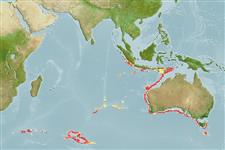Classification / Names
Common names | Synonyms | Catalog of Fishes (gen., sp.) | ITIS | CoL | WoRMS | Cloffa
Elasmobranchii (sharks and rays) >
Rajiformes (Skates and rays) >
Arhynchobatidae (Skates)
Etymology: Notoraja: Greek, noton = back + Latin, raja = fish, Raja sp. (Ref. 45335); sticta: Name from Greek 'stiktos' meaning spotted or dappled, refers to its strong blotched dorsal coloration.. More on author: Last.
Environment / Climate / Range
Ecology
Marine; bathydemersal; depth range 820 - 1200 m (Ref. 75642). Temperate, preferred ?
Eastern Indian Ocean: South Australia.
Size / Weight / Age
Maturity: Lm ? range ? - ? cm
Max length : 62.7 cm TL male/unsexed; (Ref. 75642)
Length of this species reaches at least 62.7 cm TL; adult males 52.5-54.3 cm TL, a juvenile male paratype at 50.8 cm TL, the smallest specimen was 27.1 cm TL (Ref. 75642).
Life cycle and mating behavior
Maturity | Reproduction | Spawning | Eggs | Fecundity | Larvae
McEachran, J.D. and P.R. Last, 2008. New deepwater skates of the genus Notoraja (Rajoidei: Aehynchobatidae) from southern Australia and the eastern Indian Ocean. In Last, P.R., W.T. White, J.J. Pogonoski and D.C. Gledhill (eds): Descriptions of new Australian skates (Batoidea: Rajoidei) Pg. 155-172. CSIRO marine and atmospheric research paper no. 021. (Ref. 75642)
IUCN Red List Status (Ref. 115185)
CITES (Ref. 94142)
Not Evaluated
Threat to humans
Harmless
Human uses
More information
Common namesSynonymsMetabolismPredatorsEcotoxicologyReproductionMaturitySpawningFecundityEggsEgg development
Age/Size
Growth
Length-weight
Length-length
Length-frequencies
Morphometrics
Morphology
Larvae
Larval dynamics
Recruitment
Abundance
ReferencesAquacultureAquaculture profileStrainsGeneticsAllele frequenciesHeritabilityDiseasesProcessingMass conversion
Tools
Special reports
Download XML
Internet sources
Estimates of some properties based on models
Phylogenetic diversity index (Ref.
82805): PD
50 = 0.5005 [Uniqueness, from 0.5 = low to 2.0 = high].
Bayesian length-weight: a=0.00513 (0.00253 - 0.01042), b=3.12 (2.95 - 3.29), in cm Total Length, based on LWR estimates for this (Sub)family-body shape (Ref.
93245).
Trophic Level (Ref.
69278): 3.8 ±0.7 se; Based on size and trophs of closest relatives
Resilience (Ref.
69278): Low, minimum population doubling time 4.5 - 14 years (Preliminary K or Fecundity.).
Vulnerability (Ref.
59153): High vulnerability (58 of 100) .
